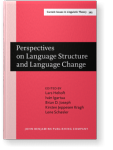Suppletion or illusion?
The diachrony of suppletive derivation
Constructing a typology and cross-linguistic survey for Aktionsart, actionality, and related notions is largely infeasible at present because so few Aktionsart systems have been fully described, they are typically complex and intricately dependent on verbal semantics and classification, and despite the inherent connection to the lexicon information about Aktionsart categories is rarely recoverable from dictionaries. As a first step this paper proposes a very minimal distinction of continuous (lacking inherent endpoints, chiefly states and activities) vs. bounded (having one or more endpoints, e.g. punctual, telic, and ingressive predicates and subtypes such as accomplishments and achievements). The word family of a predicate like sit can be based on the continuous form (as in English, where continuous sit is the base and sit down is derived) or on the bounded form (e.g. Slavic *sed- ‘sit down’ and derivative *sid-e-). A stumbling block in this endeavor has been sets like continuous know: bounded find out realize, etc. where no regular derivation relates the forms. Are they a paradigm? If so, what is the base? Structuralist criteria and Andersen's notion of markedness agreement indicate that they do form a paradigm and the continuous form is the base.
Article outline
- 1.Introduction
- 2.Issues
-
Notes
-
References
